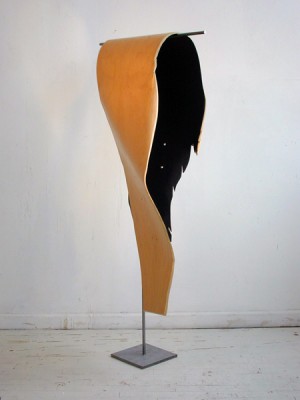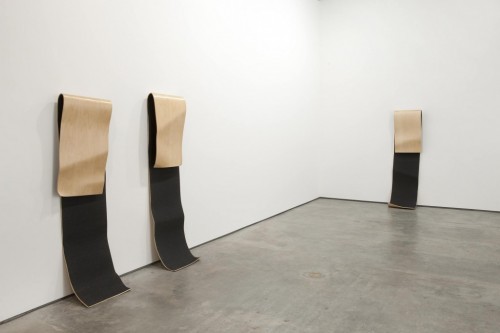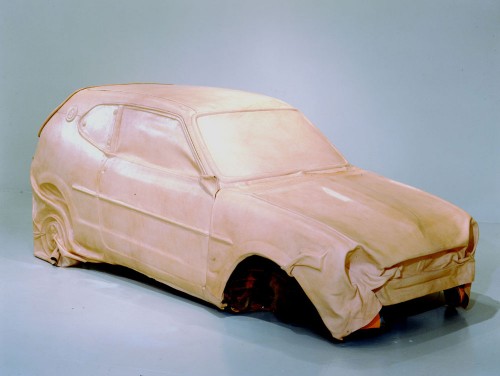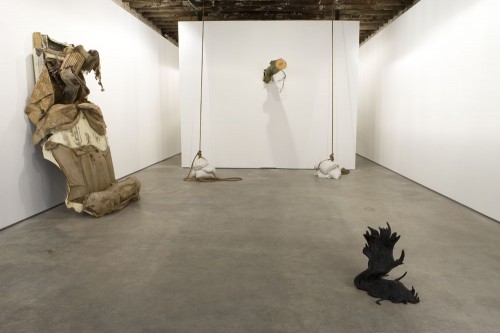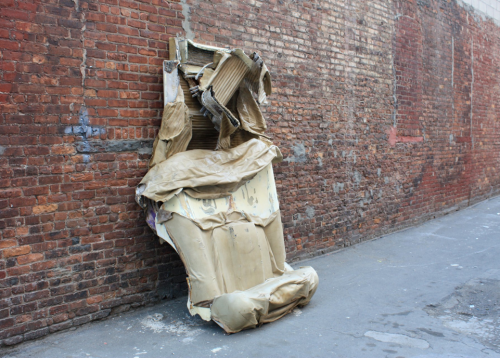FOR MICHELLE LOPEZ, the surface is all. It’s folded, glossy, wilting, crumpled, covered in glinting skateboard grip tape or high-luxe leather and else powder-coated. And, somehow in the surface truth is revealed, a truth that goes deeper than skin, deeper certainly than the powder-coated metal, but getting to that truth, you want to know your art history. She quotes the past, questioning it and subjecting it to an elegant dialogue and a rather brutal debate – sometimes involving her own work.
She borrows from (and turns the tables on) minimalism and feminism in equal parts, as if questioning one puts the other up for grabs. She can also move swiftly from the masculine minimalist heroics of John Chamberlain (he made grand gestures of metals – crashed cars and airplane parts) or John McCracken (borrowed from surfboard production to make “paintings” of planks that leaned against walls) to a near surrealism that suggests Meret Oppenheim and her furry teacup with its erotic charge, and onto Eva Hesse. It’s that play though between masculine and feminine pulled across surfaces in Lopez’s work that’s really interesting.
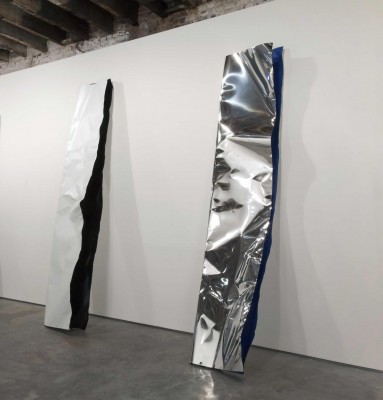
Michelle Lopez, Blue Angels, 2011, aluminum and automotive paint, Simon Preston, New York, courtesy the Artist and Simon Preston, New York.
Slick factory-made items turn frail, and questions about their inherent truths are revealed – as if showing the frailty of everything –every longing, every act of hubris. In her hands masculinity seems made to wilt, which somehow gives the pieces a sexy charge in part because of her obsession with surfaces and leather, the shiny and glinting. They are not, however, hard.
Her skateboard series Your Board sum this up. Grip tape with its silicon carbide sparkle and laminated maple are writ large, huge, in fact. The board slumps onto the wall in a sagging heap. That very idea of speed and velocity and the boy world of skateboarding seems to melt like a dream. In one interview a couple years ago she called it “a quiet subversion.” Her first pieces in the series hung delicately draped over a rod. “The wilted plywood skateboard,” she said, “was part feather, part petal… and it continues the idea of deflating cultural vehicles of speed in this case the boyhood ride. I wanted to question speed, flight, triumph by forcing the rigid board to become impossibly flaccid… What is soft is hard, straight is sagging.”
The same sagging feeling happens in her powder-coated pieces that quote McCracken and Chamberlain. Only the muscularity and rigidity of their work has vanished. Wrinkled and thin, her pieces have to lean on the wall for support. McCracken’s keen angularity is gone. Instead detumescent might be the word.
She has talked about “inverting something masculine to make something feminine” and “being interested in a feminist perspective but not a feminist aesthetic.” She is part of that generation, teens in the 80s, who grew up thinking that second-wave feminism was a bit too angry, too loud, too feminist. Judy Chicago’s aesthetic was a tad (if not outright) cringe-worthy. For years it struck me as so literal as to be awful, with an insistence like the cupcakes that made Alex Clark think of vaginas. Instead of that literalism, Lopez makes the more masculine soft, wilted and the hard on of speed is gone.
It was not always thus with her. She had a show in 2001, which should have signaled art world arrival, and yet upon that arrival a departure bigger than anyone could guess happened. The show opened in September. Now September shows are considered the most important in a dealer’s calendar (a bit like Vogue’s September issue). The show was also at Jeffrey Deitch and he the biggest of dealers in a rock-star hipster way. He’s currently the embattled director of LA’s MoCA but then he was one of the ones who decided taste. We all know, though, what happened that September, in that calendar year. Here Lopez had work that was all skins and surfaces – literally couture grade leather courtesy of the house of Nicola Trussardi and spread across things like a sports car. It was the fetish to look at how we fetishize things, and all displayed in sand. Which after 9/11 seemed wrong. All art seemed wrong, novels wrong, life wrong. Lopez retreated to California to teach at Berkeley.
Her first show back in New York was in 2009. Here she ripped apart her past. The work was savage, showing the hubris she saw in it. The sand was back – now in sandbags holding up a tree in the gallery. The tree was sycamore that had been sick and damaged, lopped by the NYC Parks Department. Lopez set to work fixing the limbs and giving the tree a resin prosthesis that had a ghostly look. Meanwhile that key piece from the 2001 show, Woadsonner, the leather sports car was crashed and destroyed. “Edited,” she called it. She also described the original as a “failed piece.” Now it was made into a wreck held to the wall like a battered mattress, like a Chamberlain only made of leather instead of metal.
~
I recently heard a talk by the radical feminist artist Sheila Pepe in which she remixed slides of her work and the terms used to describe it. It reminded me of that feminist practice of appropriating language and remixing it, taking it out of context to question what it had meant originally. It also made me think of Lopez and how she has remixed her work and how other artists like Michelle Segre and Megan Whitmarsh are questioning and quoting the past. Instead of the literalism of 70s feminism and the identity issues of the early 90s and political correctness, something new is happening. I’m not quite sure what it is, or maybe I’m only tuning in late. Or maybe by identifying it as “now,” I’m eliding a strain of activity that’s been quietly buzzing along for years through artists like Hesse up to Kiki Smith and onto the ones I’ve been writing about lately. Possibly all are true.
In any case, I’ve been thinking much of the issues of the early 90s and the 1993 Whitney Biennial that was slammed for being too aligned with identity politics. There were pins given out that read, “i can’t imagine ever wanting to be white,” which were heavy handed to say the least. This was an era where Judith Butler was big and sexual politics rife. Now I long for both the anger and also the art of that era. I think others do to. I see it in women, feminists all, plumbing feminism and other isms – minimalism, surrealism, pop – and celebrating Eva Hesse, the most famous woman minimalist there was, also the most soulful. There is something in this coming around that’s interesting (to me, at least). Often times I see things repeated and I’m apt to crack that old Marxist joke, “first time, tragedy second time farce,” but there’s something I want to understand here. I’ve been writing about it in The Weeklings hoping to get a handle on it. I can’t say I do, not the reasons, not why now – except moments circle back again, and maybe we were all a certain age, and it takes that kind of time for ideas to settle in and mature and blossom. I don’t have the answer, but a view on the question.
Lopez does too. In her artist’s statement she writes: “I’m interested in the human frailty inherent in our cultural icons. In the past, I’ve created objects that show the pristine desire of our culture, and the way it translates into how we present ourselves bodily; whether fake or not, appropriated, hybrid, hung, or vulnerable. I’m concerned with the production of culturally generated and industrially designed objects and how they subversively mirror ourselves: skateboards, cars, epic-related action figures, leather fetish, flower arrangements, monolithic Minimalism. All of these objects construct our present religious iconography.”
A solo show of her work is up at Galerie Christophe Gaillard in Paris through November 24th And more is at Michelle Lopez’s site.

